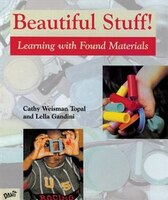During the months of September and October our class has participated in a Beautiful Stuff project. After reading a resource this summer
Beautiful Stuff! Learning with Found Materials by Cathy Weisman and Lella Gandini I was inspired to have the students help create our own materials of Beautiful Stuff.

In the past I would have collected all the materials and bought several things from the Dollar Store for the children to use in the classroom for their creations (of course I still do frequent the Dollar Store). However this year I wanted to see if more children would take to the materials when they became part of the process.
In the middle of September, we sent home a letter to the families encouraging them to fill their bag with Beautiful Stuff. We gave them suggestions of things they might find around their house. Quickly the children filled their bags and brought them back to the classroom. As soon as most of the bags were returned we had a class meeting to share some of the things within the bags.
In order to make each child feel special for the objects they had brought in, we made a point to slowly open each bag one at a time and let the children oooh and aaah over the materials dicovered within. Opening all the bags took several days and lots of anticipation.
P.T. I see lots of colours.
C.L. I see different colours of blue.
A.H. There's pink and orange,
B.Z. There's a giant,
Ms. C. You mean this sphere is very big,
C.L. I see long things and short things.
C.Y. I see beautiful things.
C.L. A marble
T.T. I see lots of stars.
A.L. I see a prism.
Ms. C. What do you see that is special?
D.Z. I see a pattern.
O.Z. Princess
Once all the bags had been opened and all the materials were mixed together in our Beautiful Stuff basket, the next step was to sort through it. In small groups the children sorted the materials various ways. Floating things, soft things, hard things, pointy things, rolling things. In the end we decided as a class we would do a final sort using a colour scheme. All the yellows together, reds together, etc...
 |
| Sorting by sticky things, things that rolls, things that twist. |
 |
| Finding different ways to sort our materials. |
 |
| Making sorting rules. |
 |
| Sorting by colour. |
Once we had all the materials sorted into the various plastic containers, during a class meeting I proposed that we co-create a Beautiful Stuff Alphabet (inspired by Joanne Babalis). In the past I have always put up the Jolly Phonics letters for the children as a reference. This year I wanted them to take ownership in creating the important resources in their classroom. I collected all the bristol board pieces needed for this project and included the Jolly Phonics picture cues for each letter (I still feel some children need these references when beginning their writing experiences).
As the days went on our co-created alphabet was beginning to take shape. Every student had a chance to work with a letter of the alphabet and decide which materials they wished to use to create the letters.
Our co-created Beautiful Stuff Alphabet is proudly displayed in the classroom as a resource for writing.



























































